#structural drawing software
Explore tagged Tumblr posts
Text
What is the Role of AutoCAD software for Structural Engineer?
The field of structural engineering is intricate, demanding precision, creativity, and efficiency. In this challenging domain, AutoCAD software has emerged as an indispensable tool. The Role of AutoCAD software for Structural Engineers is pivotal in shaping the modern skyline, from towering skyscrapers to expansive bridges. This article explores how AutoCAD has become a cornerstone in the world of structural engineering.

Transforming Structural Engineering
AutoCAD, developed by Autodesk, is a comprehensive computer-aided design (CAD) software that has revolutionized structural engineering. It provides a suite of tools that aid in the design, analysis, and visualization of structural projects.
Enhancing Design Accuracy and Efficiency
One of the critical aspects of the Role of AutoCAD software for Structural Engineers is its contribution to enhancing design accuracy. AutoCAD enables engineers to draft detailed 2D and 3D models with precise measurements, significantly reducing the margin for error. This accuracy is vital in ensuring the safety and stability of structures.
Streamlining the Design Process
AutoCAD streamlines the design process, making it more efficient. Structural engineers can quickly modify designs, experiment with different scenarios, and make real-time adjustments. This agility in design helps in meeting project deadlines and reducing overall project costs.
Collaborative Workflows
In the realm of structural engineering, collaboration is key. AutoCAD facilitates a collaborative environment, enabling multiple engineers and architects to work on the same project simultaneously. This collaboration ensures that different aspects of a project are harmonized and integrated seamlessly.
Integration with Advanced Technologies
The integration of AutoCAD with other advanced technologies like Building Information Modeling (BIM) enhances its functionality. This integration allows for a more comprehensive approach to structural design, considering all aspects of the building lifecycle.
Innovation and Customization
AutoCAD is known for its customizable nature, which allows structural engineers to tailor the software to their specific project needs. This flexibility fosters innovation, encouraging engineers to develop unique solutions to complex structural challenges.
Sustainable Design Solutions
The Role of AutoCAD software for Structural Engineers extends to promoting sustainable design solutions. The software enables engineers to analyze the environmental impact of their designs, encouraging the creation of eco-friendly and energy-efficient structures.
Educational Impact
AutoCAD has also significantly impacted the education and training of structural engineers. It is a core component of engineering curricula, equipping future engineers with essential skills for their careers.
Global Standard in Structural Engineering
AutoCAD has become a global standard in structural engineering. Its widespread adoption across the industry underscores its importance and reliability as a design tool.
Conclusion
The Role of AutoCAD software for Structural Engineers is multifaceted and invaluable. It has redefined the way structural engineers approach design, collaboration, and innovation. AutoCAD has become synonymous with precision, efficiency, and creativity in structural engineering.
For a deeper understanding of what is AutoCAD software and its role in engineering, this resource is invaluable. It provides insights into the capabilities of AutoCAD and its impact on the engineering sector.
In summary, AutoCAD is not just a tool; it's a driving force in the evolution of structural engineering.
Its role in shaping the infrastructure of the modern world is undeniable, and it will continue to be an integral part of the structural engineering landscape for years to come.
#Role of AutoCAD software for Structural Engineer#autocad software#drawing software#best drawing software#structural drawing software
1 note
·
View note
Text

Some more concept designs but this time for two guys I’ve never talked abt before oops
#keese draws#rain world#rain world oc#iterator oc#rw iterator#rain world iterator#these two are still mostly in the brainstorming phase but I do enjoy them#they share a structure and are also the worst <3#and by that I mean after the mass ascension they eventually start doing some mafia shit#synch started developing ways to carry out construction and repairs and such to the twos structure along with some renovations#the big one being to join the twos chambers so they can actually physically interact#and this gave light some ideas of ways to make sure the two would have access to enough resources to thrive long term#so they and synch worked together to develop different ways of transporting goods and supplies long distance mostly through organisms#and eventually as their fellow iterators began to slowly break down light started offering synch’s services to them#they’d use the chance to get all sorts of data scraping software into other iterators along with all sorts of other shit#and they’d use their newfound leverage over these iterators to blackmail them into giving up their resources for them and synch#often times at the threat of direct structural sabotage that they would follow up on if the iterator didn’t comply#synch is vaguely aware of the stuff that light is doing but doesn’t rly care that much since she rarely talks to other iterators#synch just wants light to be happy and would let her get away with pretty much anything
5 notes
·
View notes
Text
Presentation giving up a brief of what isdrafting in construction, its importance, types of drafting, the working process, collaborative approach and the future of drafting.
#drafting in construction#technical drawings#blueprint in construction#architectural drawings#structural drawings#MEP drawings#civil drawings#shop drawings#drafting tools#drafting software#CAD software#digital drafting#drafting process
0 notes
Text
Precision Shop Drawing Services | Transforming Designs into Construction Realities
Elevate your construction projects with our top-tier shop drawing services. From concept to reality, our experts translate designs into detailed shop drawings, ensuring accuracy and seamless collaboration. Trust us for precision and excellence in bringing your construction plans to life.
#shop drawings services#shop drawing software#structural shop drawings#fabrication drawings#fabrication drawing company in usa
1 note
·
View note
Text
Writing Tools for Planning Your Story
I've tried tons of writing apps and sites, so you don't have to. Here's a list of free sites to plot out your novel, with my review and some images of how I use it.
Milanote
Milanote is like having a giant pinboard with folders. You can upload anything onto it [yes even your main doc] and then draw over it or connect things with lines and arrows
Milanote lets you add up to a hundred things for free, not including drawing. This is one of the downsides of the site as I've found myself reaching that limit recently.
For me, the best part is being able to draw over stuff, and the color swatches.
Milanote is a lot less structured than other sites I've used, and personally, I don't think their templates are worth using.
8/10 overall, Milanote is what I mainly use. Here are some pics of how I use it:
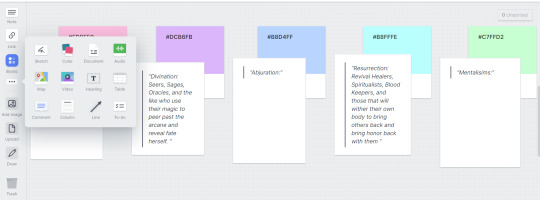
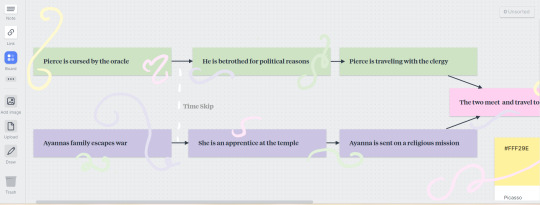
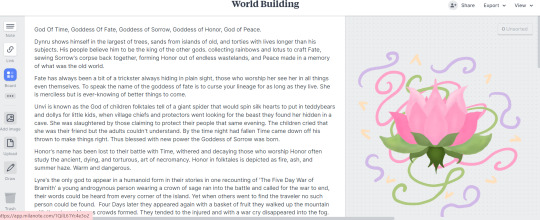
Miro
Miro is a flowchart website mainly used for corporate jobs, however, it can be a great plotting tool for that reason
Miro has a lot of great starter templates if you are looking for a more structured freeform experience. It also comes with a blank page as well.
Unfortunately, I'd argue that it's a bit of a hard tool for beginners to use without a template, I've learned copy-paste is my best friend with Miro the hard way.
It's much better than most platforms at making timelines though.
It has a limit of three boards which is a bit disappointing but overall, I think it's worth the try.
5/10 Miro is very middle of the road for me due to the limited ability to customize things and the free limit. Here are some pics:
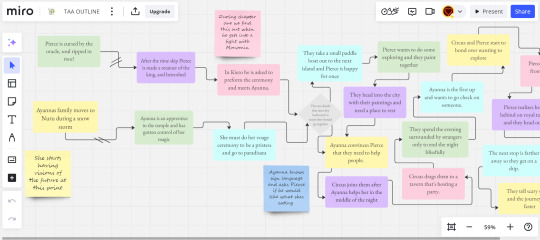
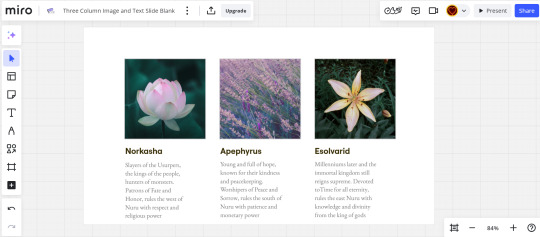
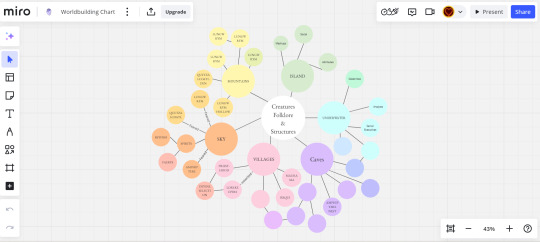
[I wrote that part weeks ago, I am now fully using Miro and believe it's the best for making timelines and charts, I just wish it let me make more boards 8/10]
Hiveword
This might be someone's jam, I can't really say it's mine though.
First off, the unpaid version is really just a few boxes saying "Write a summary here." which makes it just not worth it in my opinion
There really isn't any way to customise things which is my favorite part of most of these softwares
I've barely used this, so maybe there's something I'm missing but
1/10, Just use Google Docs at this point, here's a couple pics
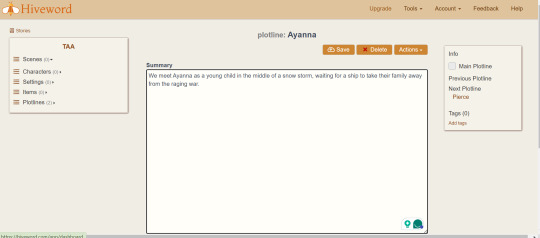

World Anvil
People like this software, it's mainly used for tabletop, which is just a different way of writing adventure, and I've seen it recommended by authors.
Unfortunately, I'm going to disagree with a lot of people and say it's hard to use and isn't even really good at plotting.
I may be biased on this one as every time I've tried to use it in the past I've struggled. However, it seems like another just write it in a document and create a folder.
I'd say it's closer to an organizing tool, but even then just use something else.
3/10, I have nothing to say about it but maybe you'll enjoy it, all here are two photos
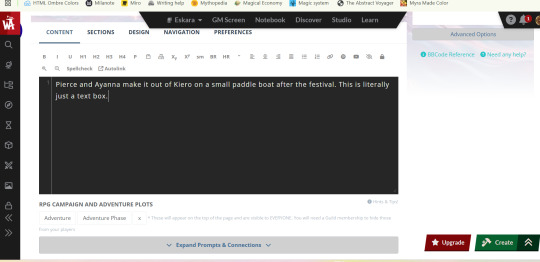

Campfire
This is the one I think I've heard the most about, but have never actually tried.
right off the bat, I'm going to say this is 100% worth it, you'll see at the end with the photos but this is like if Miro and World Anvil had an organization baby.
It's extremely easy to understand, and it makes timelines, it's more for writing your whole book but idk about that yet.
7/10, its themes are really pretty but it limits how much you can do to 20 I believe. Here are the photos
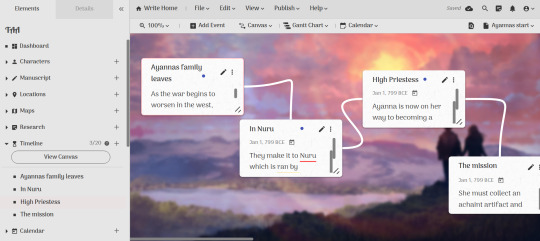
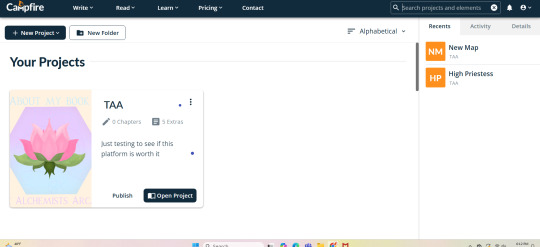
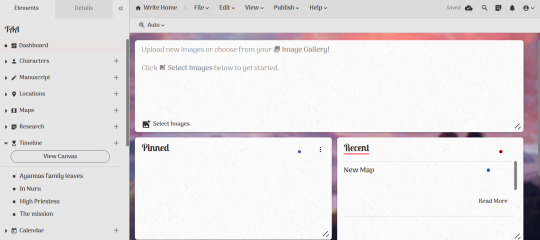
That's all for now, honestly, I think you should use Miro if you are looking to plot things out, and Milanote if you want to collect and organize your thoughts for writing, as that's what I do. Obviously what I like won't be for everyone, but hopefully, this helped you see some options
#writeblr#writers on tumblr#creative writing#worldbuilding#plotting#writing advice#writing tool#writing#writers#writing plans
1K notes
·
View notes
Text
Which Education🎓📚 is right for you?
Mercury rules your interest and consequently which type of course you would select.
Now you have to see how Mercury is placed. For example if Mercury is conjunct Moon it would have same effect as Mercury in Cancer or Moon opposite Mercury.
Mercury -Sun: It is called Budh Aditya yoga. These people can shine in political science, geology, sociology, medicine and they can be good leaders too. They may prepare for competitive exams.
Mercury-Moon: Some changes or confusion in choice of course. Can study more than one subject but both vastly different from each other. Chemical, hotel management, nutrition, chef, psychology, tarot and intuitive studies.
Mercury-Mars: Some obstacles in education, breaks and interruptions (dropping classes), engineering (especially related to machines, drawings, plans, civil, electronics), medicine (especially related to surgery), fire and safety engineering,
Mercury-Venus: Sales, marketing, HR, interior designing, makeup courses, all type of fine arts, vocational courses, acting courses.
Mercury-Saturn: Engineering (like construction , petroleum, mining core subjects), structural engineering, drafting, administrative studies.
Mercury-Jupiter: Finance, CPA, CMA, accounting, teaching, law field, journalism, VJ, pilots, aeronautical.
Mercury- Rahu: Chemical, nuclear subjects, cinematography, software courses, digital marketing, share markets, computer hardware, import export, AI, Machine Learning courses.
Mercury-Ketu: Computer coding, electrical engineering, bio technology, astrology, virology, research oriented fields.
For Readings DM
#astrology#astrology observations#zodiac#zodiac signs#astro community#astro observations#vedic astrology#astro notes#vedic astro notes#astrology community#mercury signs#mercury in aquarius#mercury retrograde#pisces mercury
857 notes
·
View notes
Text
Owlk sketches... Ha ha... Yes....
I like that you can add titles to posts on Tumblr. Makes me feel professional
Drawing Owlks is my passion and with their facial structure they are absolutely perfect to be drawn like internet cats. It's almost like owls in general are bird hardware running on cat software


Today is Monday (not really) which means the Prisoner can lick a Graham cracker. It is their favorite activity

Also bonus cuddles. If a creature has cheeks, why not squish them
#i desperately want to pet the prisoner#echoes of the eye#outer wilds#owlk#echoes of the eye spoilers#outer wilds owlk#eote spoilers#I'm sure not signing these won't have lasting consequences on the environment. I'm too lazy to get the file and sign these
271 notes
·
View notes
Text

Oh boy, VaM is kind of a trial and error experience LOL I couldn't really show you how to use the interface and stuff without a whole video or something, but it's not THAT difficult to get a hang of if you just give yourself a day or two to play around, not to mention the number of tutorials you find out there. Luckily, if you only want to use it as a reference software that makes the process far easier (to this day I have no idea how to animate on that thing, since that's not what I use it for)
As for how I use it, it's pretty self explanatory - if there's a complicated pose I want to draw but I'm either having trouble with it, or just want to double-check angles/anatomy, I will use it as a resource! I use for most of my "proper" pieces (y'know, the nicer looking ones) and every once in a while for my silly comics if I'm having trouble with a pose.
Lets use this drawing for example (the character on top of DU drow belongs to @namespara )
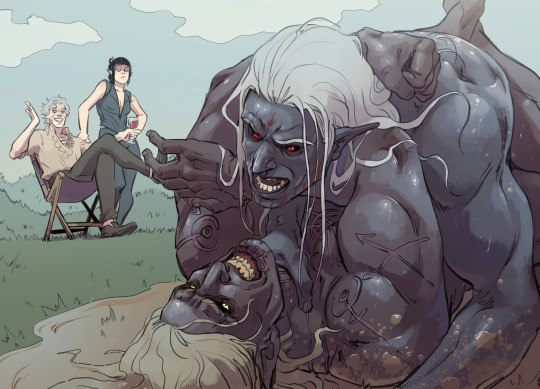
I don't draw a lot of mud-wrestling (shocking, I know) but I had an idea of the kind of pose I wanted them to be in. So the very first thing I did was make a rough sketch of what I was envisioning:
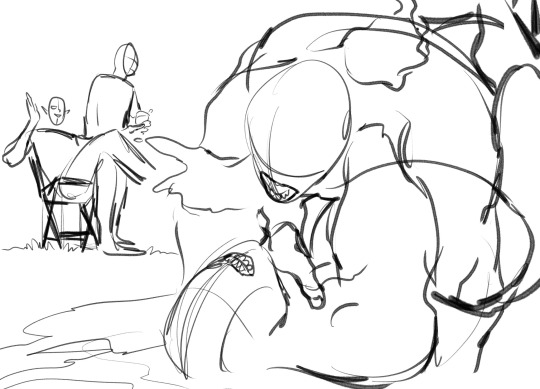
I often do a rough sketch first, even If I know I'm going to be pulling the program up because A) It's less tedious than adjusting the models over and over again until I pick a pose and B) because sometimes I'll decide I don't need the reference, after all, and so that's 30 minutes I'll have spared myself of playing around on the software.
Now, this is a pretty complicated pose! It's in a weird angle and the bodies are making contact in ways I'm not used to depicting, so I did choose to whip out VaM for this one. I went into the program and after some messing around, I flopped my little dolls together like this:
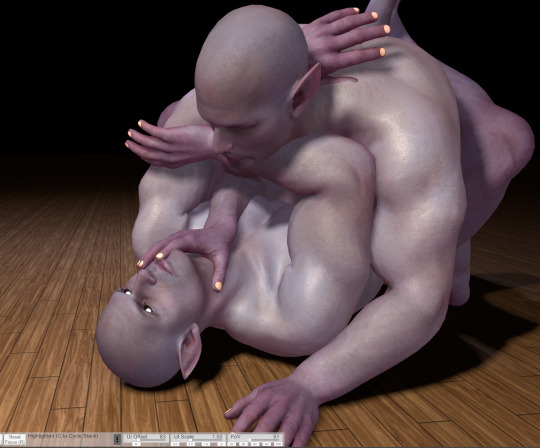
Now something really cool about VaM is that you can completely customize your models, and if you have the patience, I would definitely encourage you to do so! Obviously, you don't have to make picture perfect replicas of every single character you have, but as you can see here I have made a DU drow "decoy" to help me better understand some of his features when I draw him: he has a strong brow, a short nose, a square jawline - these are all going to look a very specific way from certain angles, and I might not always be sure of how to draw it right! So it's useful to have models that bear SOME semblance to the character so you can better understand how different viewpoints will affect their bone structure and mass.
Also thank fucking god for the elf-ear slider. Figuring out how to draw those shits from certain angles was a huge pain in the ass when I started drawing DnD races.
So, with the reference in hand, I go over the sketch again:
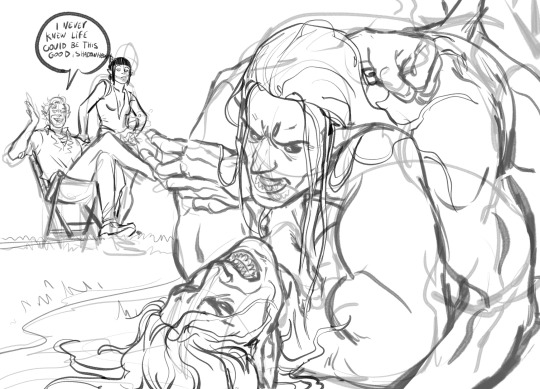
Now you may notice that I don't stick to the reference 100%. There's three reasons for this:
posing on VaM is tedious as hell. You can get something incredibly natural looking and picture-perfect to reference from if you wish, but it's going to take you hours to do. So, for the most part I just slap guys together until the results are "close enough" and use that.
In my opinion, you should always aim to ENHANCE your reference material, not replicate it exactly!
While VaM is a PRETTY DANG GOOD source of anatomical reference, it isn't perfect, I often supplement it with further reference from real life resources or make tweaks based on my own knowledge where I catch it falling short (and, antithetical to what I just said, I sometimes fuck the anatomy up further on purpose if I think it looks better that way LOL it's all jazz baby).
Then lines, color, yada yada. I don't have a tutorial on that and I don't think I could make one, because my process is chaotic as hell, but I do at times use Virt-a-mate as loose reference for lighting too when coloring - waaaaayyyy less so however, because that process is even more tedious and I feel like I often get better results by just winging it. It is a feature of the program though, and I'm sure it would be helpful for someone who has a difficult time visualizing lights and shadows. I only started using this program a few months ago, so I happened to already have a pretty good understanding of that kind of thing and just don't personally feel like I get much out of that particular mechanic.
Here's a few other examples of pieces that I made reference for (WARNING: Suggestive)
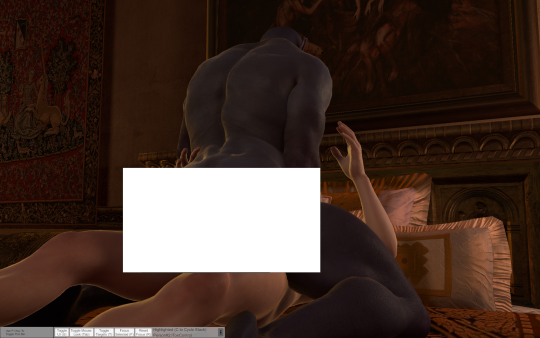
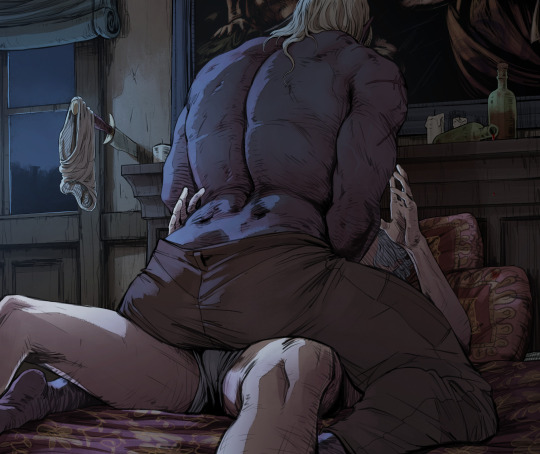
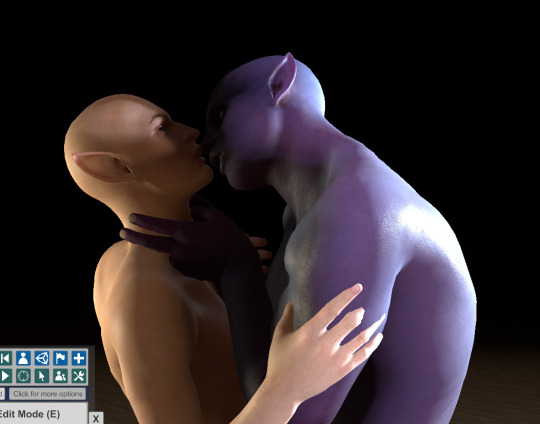
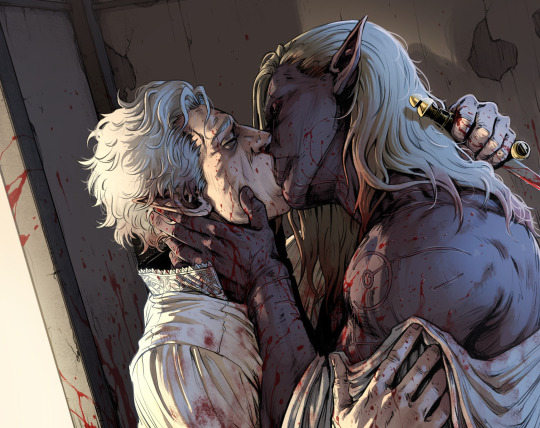
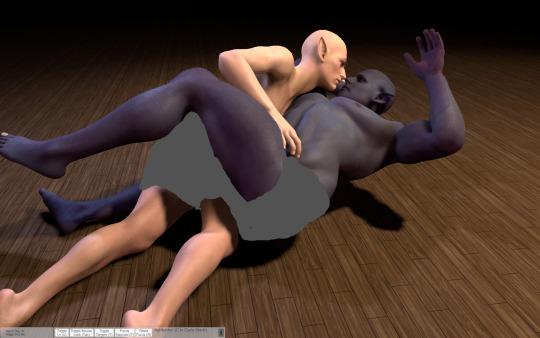
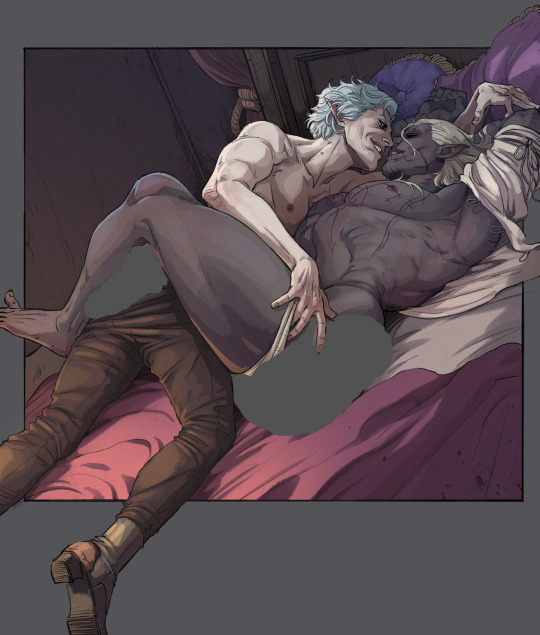
Now, for the question many of you may want to ask:
"Can I trace this junk?"
And to that, I say: Buddy, you can do whatever the hell you want with the reference material you created.
However,
If your goal is to learn and improve your art, and to recreate realistic proportions and anatomy from memory, tracing won't help you.
Developing your own style, your muscle memory, and personal technique will all be hindered by choosing to trace instead of drawing from observation, so I would encourage against it. Hell - even when tracing is employed as a technique, it's usually by high-skill realism & concept artists who are looking to either cut some corners, save time, or just double-check their own proportions in order to improve further - if you try tracing as a beginner, you will most definitely find the result to still look stiff and "off".
So trust me, there is so much more to be gained from drawing from observation. Make note of tangents, compare proportions, use all the elements of the picture to dictate where and how things should go - it will be a far more rewarding experience.
Hopefully this has been helpful! VaM is a really cheap program (you get it on the guys' patreon for I think 8 dollars, just google it!) and it's definitely been worth my money as an artist since I found it. Learning to use it can be a little intimidating at first glance, but as I said above you only really need a day plus one or two tutorials to get a hang of the interface.
A fair warning though, IT IS A SOFTWARE MADE FOR VIRTUAL SEX/ADULT ANIMATION So when looking it up expect to see a some spicy content.
#Funfact THIS is the post that got me flagged last time so i'm really tempting fate right now LOL#ask#art#tutorial#resource
689 notes
·
View notes
Text
digital notes guide part 1/5: setting up your aesthetic note-taking system 🎀
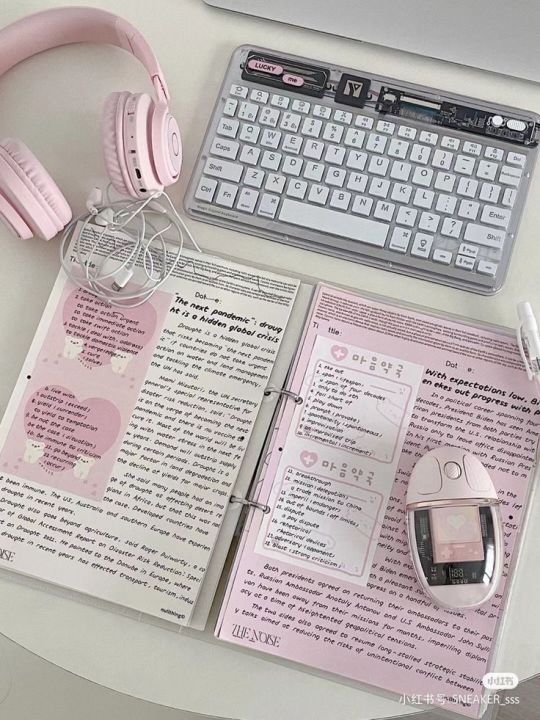
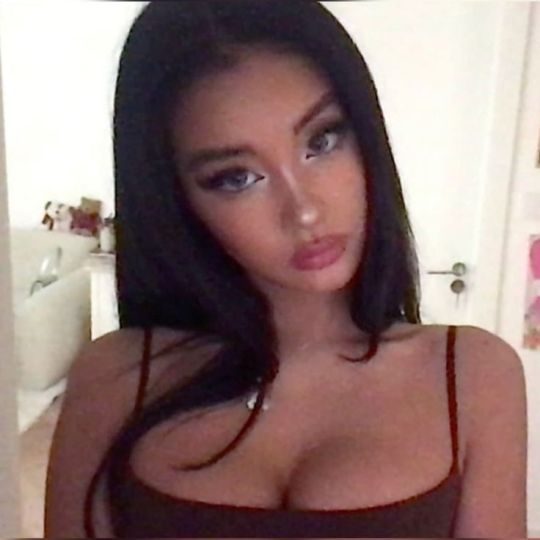
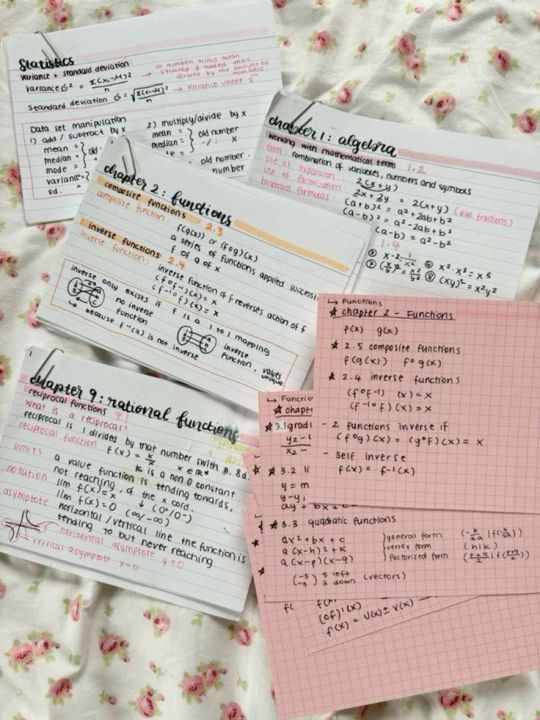

posted by: glowettee
hey study angels! ♡ mindyyy heree
omg so many of you have been asking about my digital notes setup, and i'm so excited to share all my secrets! this is going to be a 5-part series on creating the most aesthetic and effective digital notes ever. i'm going to start with the basics! this is super exciting because digital notes are literally unlimited, no wasting paper, and no perfect handwriting required.
♡ choosing your digital notebook
because the right foundation changes everything:
notion (my personal fave):
amazing for linking different pages
super customizable layouts
can embed literally everything
aesthetic cover images
databases for tracking progress
easy table of contents
goodnotes:
perfect for iPad users
feels like writing on paper
pretty digital stickers
custom paper templates
easy organization system
beautiful handwriting options
onenote:
works across all devices
infinite canvas (so dreamy!)
easy subject dividers
voice recording option
drawing capabilities
♡ essential digital tools
make sure you have these ready:
hardware needs:
reliable device (laptop/tablet)
stylus if using tablet (worth the investment!)
external keyboard (for faster typing)
good lighting for screen
comfortable study space
backup charging cables
software must-haves:
note-taking app of choice
cloud storage system
screenshot tool
pdf annotator
calendar app
backup system
♡ creating your aesthetic setup
because pretty notes = happy studying:
color scheme selection:
choose 3-4 main colors
pick 2-3 accent colors
create highlight palette
save hex codes
make color meaning system
maintain consistency
font selection:
main text font (i use garamond)
heading font (something cute!)
emphasis font
quote font
size hierarchy
spacing rules
♡ basic organization system
keep everything findable:
folder structure:
semester folders
subject folders
unit folders
topic folders
resource folders
revision folders
naming convention:
date_subject_topic
use consistent formatting
add emoji indicators
number sequence system
status markers
importance levels
♡ template creation
work smarter not harder:
essential templates:
lecture notes template
reading notes template
study guide template
revision notes template
project planner template
weekly overview template
template elements:
header section (date, subject, topic)
learning objectives area
main content space
summary section
question bank area
revision checklist
setting up your digital note system might take time, but it's so worth it! think of it like creating your perfect study sanctuary - every detail matters!
the next post will be getting into actually taking notes during class (and making them both pretty and effective!). for now, focus on setting up your perfect system.
pro tip: don't get too caught up in making everything perfect from the start. your system will evolve as you use it, just like how my notes looked completely different freshman year!
xoxo, mindy 🎀

#digitalnotes#studywithrme#studytips#productivity#studygram#studentlife#organization#girlblog#girlblogger#girlblogging#that girl#dream girl#it girl#self care#self love#glow up#becoming that girl#self help#self improvement#self development#study#studying#studyblr#college#rory gilmore#study blog#studyspo#study aesthetic#study motivation#wonyoungism
142 notes
·
View notes
Text







Architect and illustrator Rafael Araujo (born 1957 in Caracas, Venezuela) expresses his love of nature through geometry. Incorporating the golden spiral and helixes into his compositions, he uses these concepts as the basis for shells and kaleidoscopes of butterflies. The results are drawings in which the natural elements are sketched and colored in while the geometric guiding lines are left on the page.
Rafael Araujo says: "As an autodidact, my work is the outcome of years of persistence, trial an error upon the theme of tridimensional geometry and the “platonic” search of the illusion of the “Truth”, by means of the development of structures which could perfectly be described as illustrated equations of natural subjects: shells, butterflies’ spirals, etc
I do all by hand, on my drawing board with classical architectural drawing tools (a compass, protractor, squares and rules) and I do not use any kind of computer software."
142 notes
·
View notes
Note
I adore your art! I especially love how you do faces and capture the small details in expression/clothing! Do you have any tips about how to go about getting anatomy and facial structures correct? I do drawing as a hobby but I always find it so frustrating. Thanks for sharing your art with us on here :)
Thank you so much! Trust me I totally understand and I don't fully get anatomy myself.
The way I draw faces kinda kicks off from the Loomis method by drawing the circle first and then working around that. I think that's a good place to start, it's really good for face proportions and knowing where to put everything. After you do it so many times you don't need to lay everything out and you'll just know by hand. I can churn out so many faces now just drawing the circle part. I went ahead and looked online and I found a free PDF of one of his books you can take a look at :)
I still struggle with anatomy but whenever I try to figure it out I usually block in what I want on a canvas with a big dark pen and shave it down. I turn down the opacity and then try to sketch over.

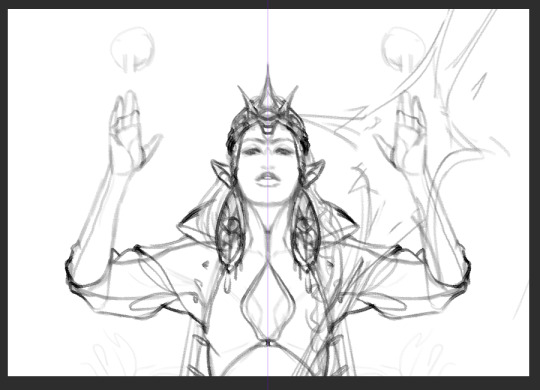
I will say, use any resources you have available to you - they are there for you to use. I always use references and If I'm still struggling to get my idea out, I'll pull up a 3d model and sketch over. It saved me a lot of tears and frustration in the end and a lot of options out there are completely free or one-time purchases.
CSP has built-in software for modeling and lots of downloadable poses, Magicposer you can use for free but some stuff is locked behind membership subscriptions. DAZ studio software is free but that one has a bit more of a learning curve to operate. Handy I think is a one-time purchase and there are many options for hand and lighting reference. These are just ones I've tried for anatomy that worked for me but I definitely encourage looking around and doing some testing with other software if you're interested!
Best of luck lovely!
52 notes
·
View notes
Text
#autoCAD Software#Drawing software#structural drawing soft#best drafting software#civil engineering software
0 notes
Text
Do you think bugs fall in love?
Their small bodies host even tinier brains. Built to crawl through soil and rocks bigger than itself. Running on a simple software bouncing between eat, sleep, fight, flight, and copulate.
V1 is smarter than a bug. It must be. It’s a war machine, so it must be. Its programming is complex enough to fry several motherboards; the internals are heated from constant, unrelenting processing needs. If it updates its optical data intake to any greater degree than these rough, messy polygons, it’d surely perish from the overwhelming information.
V1 is built to kill first, survive second. To be fair, survival would ensure more killing, so it’d be more effective. Moving through the battlefield, culling lives, drawing blood. Perfectly aligned with its programmed objectives, then.
Gabriel is smarter than a bug. He must be. He’s an angel, so he must be. He’s one of the best soldiers in the heavenly realm. Armour and swords glistened with pride and justice. He sees all. He judges all. His loyalty and perfect track record have earned him a high rank within the order. Leaving behind the creaturely "it". His light burns hot and bright within his constitution.
Gabriel is built as a messenger of the Father, then a judge of Hell. To be fair, the role of a judge was assigned to him by the council, so he supposes that his placement can be summed up as the bearer of the divine authority to bring right to all other creatures. Perfectly aligned, then.
Bugs… Well, they’re the same. I suppose. Small beings. Running pre-programmed orders derived from centuries of evolution: eat, sleep, fight, flight, and copulate. No role. No responsibilities.
Bugs are built naturally and fully, unlike humankind; but formed and ready to go within seconds from their births, like machines and angels.
So. Do they live?
When the machine and the angel escape their chains, do they see themselves in bugs?
Bugs are born to live, temporarily, fleetingly, yet live nonetheless. Do they, then, deserve to live, freeing and meaninglessly. No role. No responsibilities.
So. Do bugs love?
Do they learn that they can go beyond their basic structures? Do they see their own reflection in each other’s compound eyes? Do they recognize each other’s bodies, scents, heat? Do they feel the desire for closeness?
To flutter wings like a dance of waltz. To brush antennae like butterfly kisses. To greet and caress and lie next to each other near their death.
To move through the sky in battle, in passion. To clash swords and fists and bullets. To greet and caress and lie next to each other near their death.
The same cells in the same blood coursing beneath the same suit of exoskeletons.
Machine, angel, bug. Boiled down to the barest essence of existence; crisp simplicity.
To live, to love.
#(im thinking abt how angels have a default pronoun of it/its and went insane – they’re so bugs; like machine)#v1 ultrakill#ultrakill#gabv1el#gabriel ultrakill#az thoughts#also if this flops im flinging myself into the sun#is this any good; is it; is it <- desperate#im just really tired rn i think; its fine#wrote between lectures; thought abt queueing but whatever its fine#got like 4 group projects and a giant assignment and no free time during the last weekend i am fine i am fine i am fine#its fine for me to write Things instead of working on stuff this is destressing its fine#i need to be spun in a washing machine and left on a hanger to dry for approximately 12 hours and then ironed for way too long#<- going insane but in a bad way#someone pls take me out (date or murder; surprise me)
162 notes
·
View notes
Text
At the 2023 Defcon hacker conference in Las Vegas, prominent AI tech companies partnered with algorithmic integrity and transparency groups to sic thousands of attendees on generative AI platforms and find weaknesses in these critical systems. This “red-teaming” exercise, which also had support from the US government, took a step in opening these increasingly influential yet opaque systems to scrutiny. Now, the ethical AI and algorithmic assessment nonprofit Humane Intelligence is taking this model one step further. On Wednesday, the group announced a call for participation with the US National Institute of Standards and Technology, inviting any US resident to participate in the qualifying round of a nationwide red-teaming effort to evaluate AI office productivity software.
The qualifier will take place online and is open to both developers and anyone in the general public as part of NIST's AI challenges, known as Assessing Risks and Impacts of AI, or ARIA. Participants who pass through the qualifying round will take part in an in-person red-teaming event at the end of October at the Conference on Applied Machine Learning in Information Security (CAMLIS) in Virginia. The goal is to expand capabilities for conducting rigorous testing of the security, resilience, and ethics of generative AI technologies.
“The average person utilizing one of these models doesn’t really have the ability to determine whether or not the model is fit for purpose,” says Theo Skeadas, chief of staff at Humane Intelligence. “So we want to democratize the ability to conduct evaluations and make sure everyone using these models can assess for themselves whether or not the model is meeting their needs.”
The final event at CAMLIS will split the participants into a red team trying to attack the AI systems and a blue team working on defense. Participants will use the AI 600-1 profile, part of NIST's AI risk management framework, as a rubric for measuring whether the red team is able to produce outcomes that violate the systems' expected behavior.
“NIST's ARIA is drawing on structured user feedback to understand real-world applications of AI models,” says Humane Intelligence founder Rumman Chowdhury, who is also a contractor in NIST's Office of Emerging Technologies and a member of the US Department of Homeland Security AI safety and security board. “The ARIA team is mostly experts on sociotechnical test and evaluation, and [is] using that background as a way of evolving the field toward rigorous scientific evaluation of generative AI.”
Chowdhury and Skeadas say the NIST partnership is just one of a series of AI red team collaborations that Humane Intelligence will announce in the coming weeks with US government agencies, international governments, and NGOs. The effort aims to make it much more common for the companies and organizations that develop what are now black-box algorithms to offer transparency and accountability through mechanisms like “bias bounty challenges,” where individuals can be rewarded for finding problems and inequities in AI models.
“The community should be broader than programmers,” Skeadas says. “Policymakers, journalists, civil society, and nontechnical people should all be involved in the process of testing and evaluating of these systems. And we need to make sure that less represented groups like individuals who speak minority languages or are from nonmajority cultures and perspectives are able to participate in this process.”
81 notes
·
View notes
Text

Made to be A Monster ///// Made to be Violent
In every shape, in every form, in every kind and way, a soldier built, a weapon forged, a monster lives today Yeah. this is me again. I may endlessly hate how I look, but if there's any benefit to come out of it, it's really handy having a reference for an intimidating villain just by looking in the mirror.
Obviously this is a reference to feeling trapped in masculine roles - I looked great for a man before transitioning, and had the physical strength and skills that fit traditional masculine archetypes. No doubt this skill and experience has been a core part of my employment.
Regardless, all my closest friends have only known me as transfem for more than 11 years. Obviously that means before I used the alias veilantares. If you know who I was before and we don't already talk every day, please don't point out my old aliases.
After medical transition and being out (so in the last month or so), a fair few people have come up to me to say they looked up to me as a male role model and what a great guy I was. This has been extremely puzzling and almost unwelcome, because some of these people were students of mine who I didn't even know the names and faces of (some classes I've taught have had almost 200 students).
I've just been straightforward with everyone that's talked to me that none of that role model stuff was intentional and I've just been closeted. It's actually kinda funny because being a number of weeks into HRT I've kinda lost a lot of my forearm muscle mass and strength, so I can't properly lift a hammer any more. This should probably be devastating for a craftsman but most of my current job is around research and teaching the software process.
I haven't actually uploaded any pictures of myself to tumblr because I heard trans timelines get banned here - but on twitter I had a short period recently posting fits and selfies just cause I briefly felt confident in myself. I use myself for reference a lot and I think the parallels between my own expressions / face structure / figure and what I allow myself to draw for my robots are pretty obvious.
#veilantares#digital art#my art#art#illustration#mech#mecha#biomechanical#voidpunk#character design#monstergirl#monster girl#knight#cyborg#warrior#robot girl#robotposting#mechposting#mask#evileyedoll
28 notes
·
View notes
Note
Hi! I can't find the app you use to draw (Storyboard as you wrote in the FAQs) :(, could you tell me where to download it (or a link) or other apps recommendations please? Thank youu!! <3
Storyboard pro is the name of the software and it's the only program i use nowadays. it's not supposed to be drawing application for illustrations and stuff but i use it anyways
271 notes
·
View notes